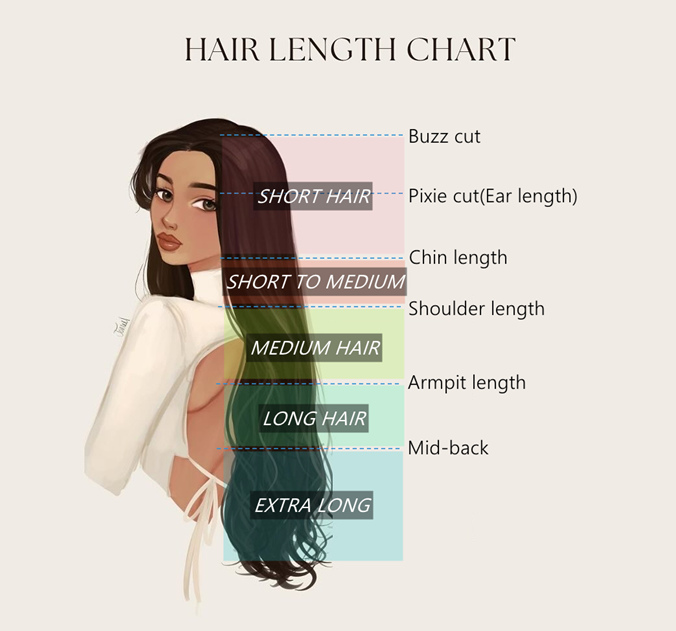Have You Ever Experienced This Hair Frustration?
💇 You showed your stylist a perfect haircut photo... only to leave the salon looking nothing like your inspiration pic.(Was it the length? The layers? Or your hair’s natural texture playing tricks?)
✂️ You asked for ‘just a trim’... but came home with hair way shorter than expected.(Damn shrinkage math – why does 4 inches of curls vanish into 1 inch after drying?)
😩 You got a trendy blunt bob... but instead of framing your face, it made your cheeks look wider. (Turns out, your "shoulder-length" wasn’t true shoulder-length due to wave pattern.)
💸 You bought expensive extensions... but they hung awkwardly because your ‘mid-back’ hair was actually collarbone-length when stretched.
The Root of All These Regrets?
Most haircut disasters happen because we misjudge three key factors:
1️⃣ Actual hair length (thanks to sneaky shrinkage)
2️⃣ How texture changes a style’s final look
3️⃣ What lengths flatter your face shape
That’s EXACTLY why we created this Hair Length Chart – your foolproof guide to:
✅ Measure hair correctly (curl types need different methods!)
✅ Pick styles that really work at your length
✅ Avoid expensive salon regrets
Consider this chart your ‘hair GPS’ – no more lost-in-translation stylist convos!
Hair Length Chart

- Short hair:Above Chin(≤6")
Buzz cut-(≤0.5")
Pixie cut-(Ear length 1-3")
- Short to medium:
Chin length(Bobs 6-10")
- Medium length hair:Shoulder to Upper back(12-16")
Shoulder/Collarbone length(Lobs12-14")
Armpit length(14-16")
- Long hair:Shoulder blades to mid-back(16-20")
- Extra long hair:Lower back length or even longer(20"+)
How to Measure Your Natural Hair Length?

The same measured length can appear different across hair textures due to natural shrinkage. The tighter the curl pattern, the more significant the shrinkage—making accurate length measurement of your natural hair an essential step before choosing haircuts or extensions.
- Straight Hair:Shows true hair length
- Wavy Hair: Shows near-true length
- Curly Hair: Appears 15-30% shorter due to bounce
- Coily Hair: Can shrink up to 50% of its stretched length
Tools You’ll Need for Hair Length Measurement:
Fine-tooth comb
Soft measuring tape (or ruler + string)
Hair clips (to section hair)
Mirror
Detailed Measure Steps:
1.Preparation:
Wash and air-dry hair without products to eliminate shrinkage.
2.Measurement
Root Positioning:Place measuring tape flush against scalp at the hairline.
Use mirror to verify proper placement at the crown
Sectioning Method:Part hair down the center,clip away top layers to isolate the bottom section.Repeat for all quadrants (front/sides/back)
A. Front: Hairline to crown (above ears)
B. Sides: Ears to parietal ridge
C. Back: Crown to nape
Strand Selection:Choose 3-5 representative strands hair with same diameter(2-3 centimeters) per section.
Stretch and measure for curly/coily hair:
Spray your hair with water until it’s damp, then pull it straight down while keeping it taut. Measure from the roots to the very tip of the hair strand.
3.Record and calculate measurements:Record individual strand measurements, calculate the average data for the true hair length.
Factors to Consider Before Choosing Your Haircut Length
Face shape
Hair length and style can dramatically transform your look by complementing your face shape. While classic and trendy bold cuts often target specific facial structures, these general recommendations from experienced hairstylists can help guide your decision. If you’re still unsure after reviewing these tips, we always recommend consulting a professional stylist at your local salon.
Round faces: Longer layers or medium-length cuts can elongate the face.
Square faces:Asymmetrical layered cuts or Soft, wavy styles can soften angles and flattering your jawline.
Oval faces: Almost any length works, but mid-length cuts with middle part bangs are especially flattering.
Heart-shaped faces:Pixie cuts,pull back bob,or Chin-length bobs or shoulder-length cuts can harmonize the forehead and chin.
Oblong faces:Layered lobs paired with side-parted long bangs or shag bangs are good choices to add volume,creating width and proportion.
Hair Type and Texture
Straight, wavy, curly, and coily hair each behave differently when cut to identical lengths.Additionally, the natural shape of hair textures create distinct effects to your face :
- Straight hair
Straight hair tends to fall smoothly, emphasizing sharp lines.
Short Lengths (Pixie/Bob):
✓ Best for: Heart, Oval
✦ Creates angular contrast for round faces
✦ Highlights delicate jawlines (heart shapes)
Medium-Long Lengths:
✓ Best for: Square, Round
✦ Blunt ends soften square jaws
✦ Face-framing layers elongate round faces
- Wavy Hair
Shoulder-Length (Lob):
✓ Best for: Round, Square
✦ Natural volume balances wide cheekbones
✦ Beachy waves diffuse strong jawlines
Long Layers:
✓ Best for: Oval, Heart
✦ Enhances natural movement without widening
- Curly Hair (2C-3C)
Chin-Length Bob:
✓ Best for: Square, Heart
✦ Springy curls soften angles
✦ Opens up narrow chins
Mid-Back Length:
✓ Best for: Oval, Long
✦ Weight prevents triangular shape
✦ Curtain bangs shorten long faces
- Coily Hair(4A-4D)
✓ Best for: Diamond, Oval
✦ Highlights bone structure
✦ Minimizes width at cheeks
Shoulder-Length Protective Styles:
✓ Best for: Round, Square
✦ Braids/twists create vertical elongation
✦ Crown volume balances wide jaws
Hair health condition
If your hair is chemical damaged or thinning, shorter cuts can help remove split ends,create the appearance of thicker hair and reduce the pressure of your scalp,promoting healthier hair growth.
Hair growth speed and maintain difficulty
You might arrive at the salon with a perfect haircut in mind, only to regret going too short—especially if you're used to long locks. For those who've had long hair for years, remember: hair grows slowly (about ½ inch per month),before taking the plunge, consider:
✔ Your growth timeline – That chic pixie cut may require 2+ years to return to shoulder length
✔ Texture changes – Layers/curls can make regrowth stages trickier to style
✔ Maintenance needs
– Short cuts require more frequent trims (every 4-6 weeks).
– loose perm curls demand extra care to preserve definition to maintain shape and structure,regular deep conditioning and styling products are essential.

Comments(0)